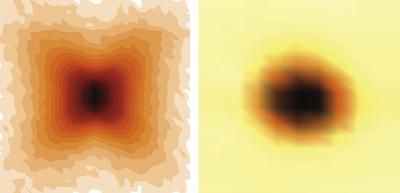Squeezed crystals deliver more volts per jolt
Advertisement
A discovery by scientists at the Carnegie Institution has opened the door to a new generation of piezoelectric materials that can convert mechanical strain into electricity and vice versa, potentially cutting costs and boosting performance in myriad applications ranging from medical diagnostics to green energy technologies.
High-performance piezoelectric materials used today, such as those in probes for medical ultrasound, are specially grown crystals of mixed composition known as "solid solutions," making them difficult to study and expensive to manufacture. But a research team led by Ronald Cohen and Russell Hemley of the Carnegie Institution's Geophysical Laboratory report that at high pressure pure crystals of lead titanate show the same transitions seen in more complex materials. Moreover, theory predicts that lead titanate under pressure has the largest piezoelectric response of any material known. This suggests the exciting possibility of low-cost but extremely high-performance piezoelectrics.
"The most useful piezoelectric materials have a critical range of compositions called the morphotopic phase boundary, where the crystal structure changes and the piezoelectric properties are maximal," says Muhtar Ahart, a co-author of the study. "These are usually complex, engineered, solid solutions. But we showed that a pure compound can display a morphotopic phase boundary under pressure."
For the study, the researchers placed powdered crystals of lead titanate in a device called a diamond anvil cell, which can generate pressures exceeding those at the center of the Earth. They monitored the changes in crystal structure with pressure using high-energy X-ray beams of the Advanced Photon Source at Argonne National Laboratory in Illinois. Using this data and calculations based on first-principle theoretical computations, the researchers were able to determine the piezoelectric properties of the pure crystals at different pressures.
"It turns out that complex microstructures or compositions are not necessary to obtain strong piezoelectricity," says Ahart.
Original publication: Muhtar Ahart, Maddury Somayazulu, R. E. Cohen, P. Ganesh, Przemyslaw Dera, Ho-kwang Mao, Russell J. Hemley, Yang Ren, Peter Liermann, and Zhigang Wu; Nature 2008.
Most read news
Organizations
Other news from the department science

Get the chemical industry in your inbox
By submitting this form you agree that LUMITOS AG will send you the newsletter(s) selected above by email. Your data will not be passed on to third parties. Your data will be stored and processed in accordance with our data protection regulations. LUMITOS may contact you by email for the purpose of advertising or market and opinion surveys. You can revoke your consent at any time without giving reasons to LUMITOS AG, Ernst-Augustin-Str. 2, 12489 Berlin, Germany or by e-mail at revoke@lumitos.com with effect for the future. In addition, each email contains a link to unsubscribe from the corresponding newsletter.




























































